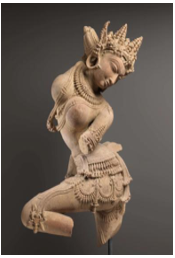Recently, 1,440 smuggled antiquities seized by US authorities returned to India.

- One of the returned sculptures is a Celestial Dancer, stolen from a temple in Madhya Pradesh in the early 1980s and another is the Tanesar Mother Goddess, taken from the village of Tanesara-Mahadeva in Rajasthan in the early 1960s.
- An antiquity refers to any object, article, or work of art that is at least 100 years old.
- According to India’s Antiquities and Art Treasures Act (AATA) 1972, it includes items like coins, sculptures, paintings, manuscripts, or any article illustrating history, science, art, religion or culture.
- The UNESCO 1970 Convention defines “cultural property” as items with importance for archaeology, history, literature, art, or science.
- To combat fake antiquities, the National Mission on Monuments and Antiquities has registered a significant number of items to ensure authenticity and curb illegal activities.
- India can seek the return of antiquities in three categories:
- Pre-independence: Items taken before 1947.
- Post-independence (until 1976): Items taken before the AATA came into effect.
- Post-1976: Items taken after the AATA’s enforcement.
- For items in the second and third categories, India can request their return using proof of ownership and the UNESCO convention.
The Antiquities and Art Treasures Act (AATA):
- Only the Central Government or authorized agencies can export antiquities or art treasures.
- No one can sell or offer to sell antiquities unless they have a license, which is granted by the Archaeological Survey of India (ASI).
- After the AATA was enacted, the government required traders and individuals to declare their antiquities by June 5, 1976 and July 5, 1976, respectively.
